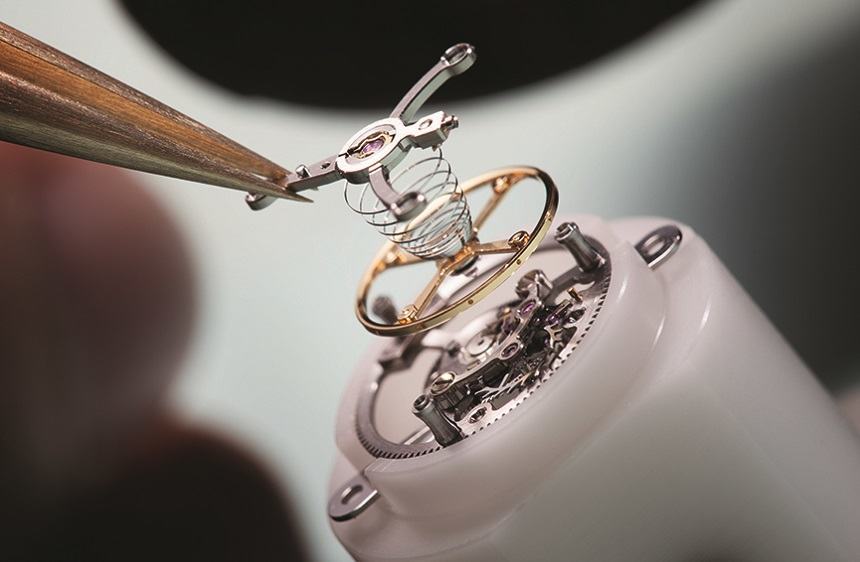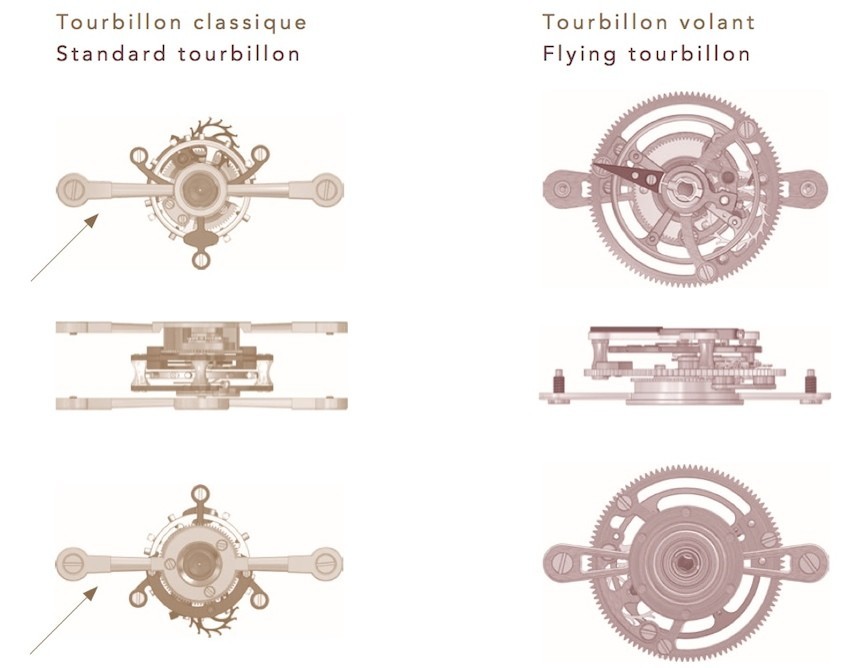Tourbillon Watch
Tourbillon (“whirlwind” in French) is a gravity-defying device in watch’s movement to improve the accuracy of a watch.
뚜르비용(프랑스어로 “회오리바람”이라는 뜻)은 시계의 정확성을 향상시키기 위해 시계의 무브먼트에서 중력을 거스르는 장치입니다.
The first tourbillon watch was invented in 1795 by the French watchmaker – Abraham-Louis Breguet.
최초의 뚜르비용 시계는 1795년 프랑스의 시계 제작자인 아브라함 루이 브레게가 발명했습니다.
Pocket watches, the only portable timekeepers at Breguet’s time, were worn in the pocket in a vertical position.
브레게의 당시 유일한 휴대용 시계인 포켓 워치는 주머니에 수직으로 넣어야 했습니다.
Breguet discovered this consistent orientation caused a constant downwards gravitational pull that adversely affected the watch’s accuracy.
브레게는 이렇게 한 방향으로 계속 휴대하는 것이 시계의 정확성에 부정적인 영향을 미치는 지속적인 하향 중력의 끌어당김이 발생한다는 사실을 발견했습니다.
To remedy this, Breguet invented the tourbillon, a continuously rotating cage that houses the watch’s escapement and balance wheel.
이를 해결하기 위해 브레게는 시계의 이스케이프먼트와 밸런스 휠을 수용하는 연속 회전 장치인 뚜르비용을 발명했습니다.
By rotating at a fixed rate, the tourbillon negates the force of gravity on a watch’s movement, thus vastly improving accuracy.
고정 비율로 속도로 회전함으로써 뚜르비용은 시계 무브먼트의 중력을 상쇄하여 정확도를 크게 향상시킵니다.
Tourbillon is usually exposed on the watch’s dial to showcase it.
뚜르비용은 일반적으로 시계의 다이얼에서 볼 수 있도록 노출되어 있습니다.
Although quartz movements and atomic clocks have rendered the tourbillon unnecessary for accuracy, it remains a centerpiece in today’s luxury mechanical watches as a symbol of watchmaking mastery. Celebrated as a display of craftsmanship, it commands a very high price and is particularly favored by male collectors.
쿼츠 무브먼트와 원자 시간 측정으로 인해 뚜르비용은 의미없는 발명이 되었지만, 오늘날의 럭셔리 기계식 시계에서는 여전히 시계 제작 장인 정신을 상징하는 핵심 요소로 자리 잡고 있습니다. 장인정신을 보여주는 대표적인 장치로 높이 평가되며, 매우 높은 가격대를 형성하고 특히 남성 컬렉터들에게 큰 인기를 얻고 있습니다.
Over time, watchmakers have developed many variations. The main types of tourbillons include: flying tourbillon, double-aix tourbillon and triple-aix tourbillon.
시간이 지나면서 시계 제작자들은 다양한 변형을 발전시겼습니다. 뚜르비용의 주요 유형에는 플라잉 뚜르비용, 더블 액시스(이중 축) 뚜르비용, 그리고 트리플 액시스(삼중 축) 뚜르비용이 있습니다.
Flying Tourbillon is the second-generation tourbillon was designed by Alfred Helwig in 1920.
2세대 뚜르비용인 플라잉 뚜르비용은 1920년 알프레드 헬위그가 디자인했습니다.
The main difference between a standard tourbillon and a flying tourbillon is that a flying tourbillon has no upper bridge for the cage, it’s supported only from below. It is called “flying” because it appears to hover in the air.
표준 뚜르비용과 플라잉 뚜르비용이 가지는 가장 큰 차이점은, 플라잉 뚜르비용에는 케이지를 위한 상부 브리지 없이 아래쪽에서만 지탱된다는 것입니다. 공중에 떠있는 것처럼 보이기 때문에 “플라잉”이라고 합니다.
The main purpose of using a single support is to make it easier to ogle the tourbillon’s action.
단일 지지대를 사용하는 주요 목적은 뚜르비용의 움직임을 더 쉽게 눈에 띄게 하기 위한 것입니다.
The double-axis tourbillon was invented by Anthony Randall in 1977. It is a type of tourbillon where the cage rotates on two perpendicular axes (instead of just one), which allows the balance wheel and escapement to change position in more directions. This design improves timekeeping accuracy by further reducing the effect of gravity compared to a classic single-axis tourbillon.
더블 액시스(이중 축) 뚜르비용은 1977년 앤서니 랜달에 의해 발명되었습니다. 이 뚜르비용은 케이지가 한 개의 축이 아닌 서로 수직인 두 개의 축을 따라 회전하는 방식으로, 밸런스 휠과 이스케이프먼트가 더 다양한 방향으로 위치를 바꿀 수 있게 합니다. 이러한 설계는 고전적인 단일 축 뚜르비용과 비교했을 때, 중력의 영향을 더욱 줄여 시간 측정의 정확성을 향상시킵니다.
The triple-axis tourbillon was invented by Thomas Prescher in 2004. It is a highly complex tourbillon where the cage rotates on three different axes, creating a multi-dimensional rotation like a 3D gyroscope. This design further minimizes the influence of gravity on the balance wheel and escapement, while also producing a spectacular visual effect.
트리플 액시스(삼중 축) 뚜르비용은 2004년 토마스 프레셔에 의해 발명되었습니다. 이 뚜르비용은 케이지가 세 가지 서로 다른 축을 따라 회전하는 매우 복잡한 구조로, 마치 3D 자이로스코프와 같은 다차원적 회전을 만들어냅니다. 이러한 설계는 밸런스 휠과 이스케이프먼트에 미치는 중력의 영향을 더욱 최소화하는 동시에, 시각적으로도 압도적인 효과를 제공합니다.
A modern single tourbillon is usually made of about 70 to 80 tiny parts, yet the entire cage weighs less than half a gram. A double-axis tourbillon is more complicated, with two cages rotating inside one another. It often has over 100 parts and weighs a bit more than a single tourbillon, but still stays very light, usually under one gram. A triple-axis tourbillon adds a third cage, making the mechanism even more complex. These can include 130 to 150 or more components, with a moving system that typically weighs only 1 to 1.5 grams, which is remarkably light for such intricate engineering.
단일 뚜르비용은 보통 약 70~80개의 작은 부품으로 구성되지만, 전체 케이지의 무게는 0.5그램 미만에 불과합니다. 더블 액시스 뚜르비용은 두 개의 케이지가 서로 안쪽과 바깥쪽에서 회전하는 더 복잡한 구조로, 보통 100개 이상의 부품으로 이루어져 있습니다. 무게는 단일 뚜르비용보다 조금 더 나가지만, 여전히 매우 가볍게 유지되어 보통 1그램 미만입니다. 트리플 액시스 뚜르비용은 세 번째 케이지를 추가하여 메커니즘이 한층 더 정교해집니다. 이러한 구조는 보통 130~150개 이상의 부품을 포함하며, 무게도 대개 1~1.5그램 정도에 불과합니다. 이렇게 복잡한 구조를 고려하면 놀라울 정도로 가볍습니다.
In general, many luxury watchmakers use titanium to build the tourbillon, keeping it as light as possible. But not all brands take this approach — some stick with traditional materials like steel or brass, while others push innovation with advanced options such as silicon or carbon composites.
일반적으로 럭셔리 워치 메이커는 티타늄으로 뚜르비옹을 제작하여 그 무게를 최대한 가볍게 유지합니다. 하지만 모든 브랜드가 그렇게 하는 건 아닙니다. 어떤 브랜드는 스틸이나 황동 같은 전통적인 소재를 쓰기도 하고, 또 어떤 브랜드는 실리콘이나 카본 복합 소재처럼 새로운 첨단 소재를 시도하기도 합니다.


In watchmaking, a retrograde display is when a hand moves forward but, instead of completing a full circle, it jumps back to the starting point and begins again. On the Chanel J12 Rétrograde Mystérieuse, the crown is placed on the dial at 3 o’clock rather than on the case side. A normal rotating minute hand would strike the crown once every hour, so the watchmakers solved this with a retrograde mechanism. For about ten minutes each hour, the minute hand flips backward to avoid the crown, then continues moving forward as usual.